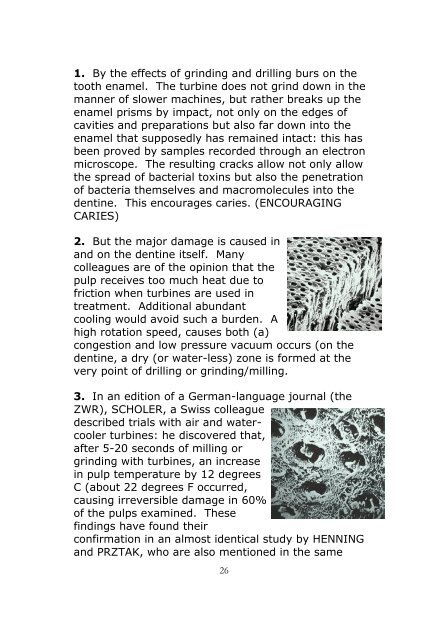Saved by My Dentist - New Solutions to a Health ... - Get a Free Blog
Saved by My Dentist - New Solutions to a Health ... - Get a Free Blog
Saved by My Dentist - New Solutions to a Health ... - Get a Free Blog
Create successful ePaper yourself
Turn your PDF publications into a flip-book with our unique Google optimized e-Paper software.
1. By the effects of grinding and drilling burs on the<br />
<strong>to</strong>oth enamel. The turbine does not grind down in the<br />
manner of slower machines, but rather breaks up the<br />
enamel prisms <strong>by</strong> impact, not only on the edges of<br />
cavities and preparations but also far down in<strong>to</strong> the<br />
enamel that supposedly has remained intact: this has<br />
been proved <strong>by</strong> samples recorded through an electron<br />
microscope. The resulting cracks allow not only allow<br />
the spread of bacterial <strong>to</strong>xins but also the penetration<br />
of bacteria themselves and macromolecules in<strong>to</strong> the<br />
dentine. This encourages caries. (ENCOURAGING<br />
CARIES)<br />
2. But the major damage is caused in<br />
and on the dentine itself. Many<br />
colleagues are of the opinion that the<br />
pulp receives <strong>to</strong>o much heat due <strong>to</strong><br />
friction when turbines are used in<br />
treatment. Additional abundant<br />
cooling would avoid such a burden. A<br />
high rotation speed, causes both (a)<br />
congestion and low pressure vacuum occurs (on the<br />
dentine, a dry (or water-less) zone is formed at the<br />
very point of drilling or grinding/milling.<br />
3. In an edition of a German-language journal (the<br />
ZWR), SCHOLER, a Swiss colleague<br />
described trials with air and watercooler<br />
turbines: he discovered that,<br />
after 5-20 seconds of milling or<br />
grinding with turbines, an increase<br />
in pulp temperature <strong>by</strong> 12 degrees<br />
C (about 22 degrees F occurred,<br />
causing irreversible damage in 60%<br />
of the pulps examined. These<br />
findings have found their<br />
confirmation in an almost identical study <strong>by</strong> HENNING<br />
and PRZTAK, who are also mentioned in the same<br />
26


